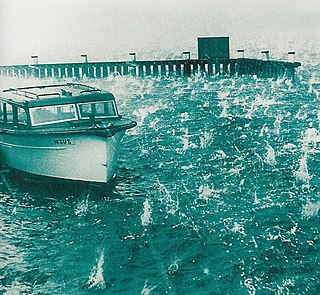Related Research Articles

Hail is a form of solid precipitation. It is distinct from ice pellets, though the two are often confused. It consists of balls or irregular lumps of ice, each of which is called a hailstone. Ice pellets generally fall in cold weather, while hail growth is greatly inhibited during low surface temperatures.

The World Meteorological Organization (WMO) is a specialized agency of the United Nations responsible for promoting international cooperation on atmospheric science, climatology, hydrology and geophysics.

A thunderstorm, also known as an electrical storm or a lightning storm, is a storm characterized by the presence of lightning and its acoustic effect on the Earth's atmosphere, known as thunder. Relatively weak thunderstorms are sometimes called thundershowers. Thunderstorms occur in a type of cloud known as a cumulonimbus. They are usually accompanied by strong winds and often produce heavy rain and sometimes snow, sleet, or hail, but some thunderstorms produce little precipitation or no precipitation at all. Thunderstorms may line up in a series or become a rainband, known as a squall line. Strong or severe thunderstorms include some of the most dangerous weather phenomena, including large hail, strong winds, and tornadoes. Some of the most persistent severe thunderstorms, known as supercells, rotate as do cyclones. While most thunderstorms move with the mean wind flow through the layer of the troposphere that they occupy, vertical wind shear sometimes causes a deviation in their course at a right angle to the wind shear direction.
Hailstorm over Truk Lagoon is a book by Klaus Lindemann about the shipwrecks of Truk lagoon. The wrecks were caused by Operation Hailstone, a US Navy aerial attack on the Japanese-held islands of the lagoon on 17 and 18 February 1944. American naval forces neutralized the lagoon's offensive capacity but did not try to capture it; instead they leapfrogged the islands and captured the Mariana Islands, which were within bomber range of Japan.

Moradabad is an industrial city, commissionerate, and municipal corporation in Moradabad district of the Indian state of Uttar Pradesh. It is situated on the banks of the Ramganga river, at a distance of 192 km (119 mi) from the national capital, New Delhi and 356 km north-west of the state capital, Lucknow. Based on the 2011 census, it is 10th most populous city in the state and 54th most populous city in the country. It is one of the largest cities in the Western UP region, serving as a crucial hub for employment, education, industry, culture, and administration.
This table shows record weather extremes in Canada.

Severe storms in Australia refers to the storms, including cyclones, which have caused severe damage in Australia.

Moradabad district is one of the districts of Uttar Pradesh, India. The city of Moradabad is the district headquarters. Moradabad district is part of Moradabad division. It used to be the second most populous district of Uttar Pradesh out of 75 after Prayagraj till a new district Sambhal was carved out of it in 2011.
Severe weather is any dangerous meteorological phenomenon with the potential to cause damage, serious social disruption, or loss of human life. These vary depending on the latitude, altitude, topography, and atmospheric conditions. High winds, hail, excessive precipitation, and wildfires are forms and effects, as are thunderstorms, downbursts, tornadoes, waterspouts, tropical cyclones, and extratropical cyclones. Regional and seasonal phenomena include blizzards,snowstorms, ice storms, and duststorms.

The 1999 Sydney hailstorm was the costliest natural disaster in Australian insurance history, causing extensive damage along the east coast of New South Wales. The storm developed south of Sydney on the afternoon of Wednesday, 14 April 1999, and struck the city's eastern suburbs, including the central business district, later that evening.

The 1947 Sydney hailstorm was a natural disaster which struck Sydney, Australia, on 1 January 1947. The storm cell developed on the morning of New Year's Day, a public holiday in Australia, over the Blue Mountains, hitting the city and dissipating east of Bondi in the mid-afternoon. At the time, it was the most severe storm to strike the city since recorded observations began in 1792.
The Alberta Hail Project was a research project sponsored by the Alberta Research Council and Environment Canada to study hailstorm physics and dynamics in order to design and test means for suppressing hail. It ran from 1956 until 1985. The main instrument in this research was an S-band circularly polarized weather radar located at the Red Deer Industrial Airport in central Alberta, Canada.

Lahore features a five-season semi-arid climate, bordering a humid subtropical climate, with five seasons: foggy winter with few western disturbances causing rain; pleasant spring ; summer with dust, rain storms and heat wave periods; rainy monsoon ; and dry autumn. However, in some cases, it can be classified as being humid subtropical (Cwa), rather than semi-arid, since it has well defined seasons and an ample amount of rain. It occasionally has very prolonged and dense monsoons, typical of a humid subtropical climate.

The Croatian Meteorological and Hydrological Service is a public entity for meteorology, hydrology and air quality in Croatia.

On the morning of March 9, 2012, a long-lived hailstorm hit the Hawaiian islands of Oahu and Lanai. The hailstorm was produced by a supercell thunderstorm. This event produced the largest hailstone ever recorded in Hawaii since records began in 1950. The hailstone was measured at 4.25 in (10 cm) long, 2.25 in (6 cm) tall, and 2 in (5 cm) wide. National Weather Service meteorologist Tom Birchard stated that the event was "unprecedented."
Hailstorm Alley is a colloquial term referring to an area of south and central Alberta, Canada where hail storms are frequently produced. These storms frequently produce hail that is damaging to property. This area stretches from High River in southern Alberta, northward through Calgary, through Red Deer to Lacombe and then westward to Rocky Mountain House. It is known to be one of the worst areas in the world for damaging hail produced by thunderstorms. These are regarded as loose boundaries. While this area is common for damaging hailstorms, the reality is damaging hailstorms occur over much of central and southern Alberta every summer. The City of Calgary is regarded as the hailstorm capital of Canada.

The July 1968 United Kingdom thunderstorms were the most severe dust fall thunderstorms in the British Isles for over 200 years. A layer of mineral dust blowing north from the Sahara met cold, wet air over the British Isles, resulting in thick, dense clouds and severe thunderstorms across most of England and Wales. These clouds completely blotted out the light in some areas and the rain and hail resulted in property damage and flooding, and at least four people were killed. During the storm, Leeming Bar in North Yorkshire saw 35.7 millimetres (1.41 in) of rain in under 10 minutes – a UK record until 2003.
The 1808 United Kingdom heat wave was a period of exceptionally high temperatures during July 1808. In the Central England Temperature series, dating back to 1659, at the time it was the 2nd hottest July on record, the hottest since 1783. As of 2022, it is the 9th hottest July on record. The month included some of the highest temperatures ever recorded in the UK. Temperature records from this time are likely dubious as the Stevenson screen was not introduced until the 1860s.
On May 15, 1697, a severe hailstorm tracked south-westwards between the towns of Hitchin (Hertfordshire) and Potton (Bedfordshire) in Southern England. The storm moved slowly, beginning at 9 am and finishing by 2 pm local time. The parent storm's total track length was at least 25 km (16 mi) long. This hailstorm is widely considered to be the worst hailstorm ever documented in the United Kingdom, with the largest hail ever measured in addition. Widespread damage to property was reported where the hailstorm had passed through, with slate roof tiles smashed to pieces and resulting in at least 1 death.
References
- ↑ "WMO Assessment of Weather and Climate Mortality Extremes". World Meteorological Organization . Retrieved 19 April 2024.
- ↑ "Highest Mortality Hailstorm". World Meteorological Organization . Retrieved 19 April 2024.
- ↑ "Do You Know About the Deadliest Hailstorms?". DownToEarth.org. Retrieved 19 April 2024.